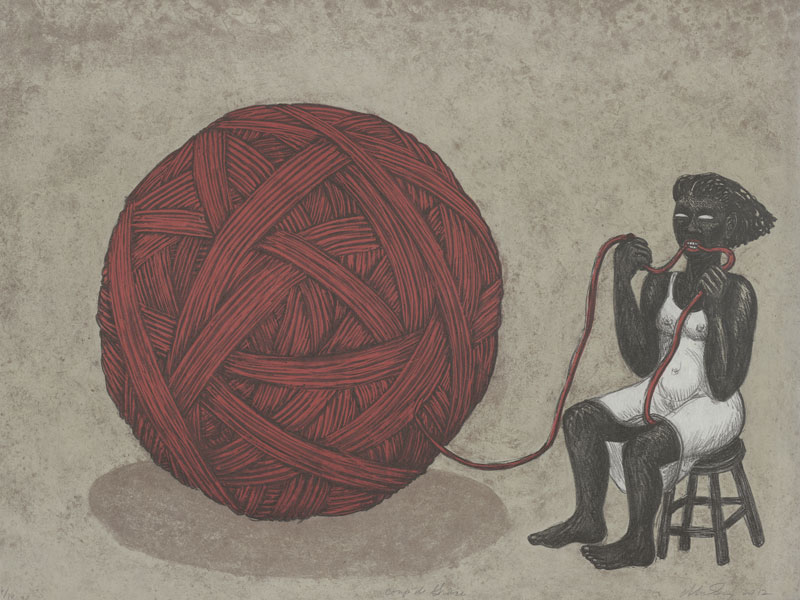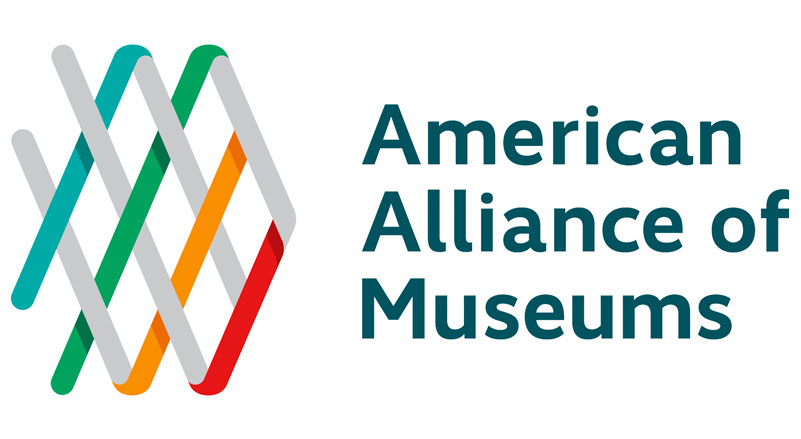
RELEASE DATE: OCT 10, 2019
The Weatherspoon Art Museum at UNC Greensboro is pleased to present the exhibition Mirror, Mirror: The Prints of Alison. Alison Saar is known not only for her powerful sculptures—she is also a master of the art of printmaking. In both forms, she employs a personal vocabulary informed by history, race, and mythology. Her influences range from ancient Europe, Africa, and American Folk Art, and she is especially drawn to the Kouros, an ancient Greek sculptural form of a man in the diametric pose of stillness and movement.
In addition to 46 prints, including the portfolios “Arcade Suite” and “Copasetic Portfolio,” the exhibition includes six sculptures. Saar often creates related prints and sculptures, such as “White Guise” and “Pallor Tricks.” Her works narrate stories of the African American experience, moving effortlessly from the personal to the political. In many of them, while she charts the tragic history of slavery in America, her figures symbolize defiance and strength. Other recurring images are informed by jazz, romance, and desire.
Saar has explored almost every conceivable form of printmaking, both in process and materials. Her prints include woodcuts, linoleum cuts, etchings, serigraphs, intaglios, lithographs, and monoprints, among other formats. She has printed upon paper, stained cotton shop rags, found sugar shack quilts, and vintage seed sacks. In some cases, she incorporates collage elements, hand-applied pigments, shellac, and chine-collé. Her sculptures also are notable for their combination of materials, from ceramic, cotton bolls, wood, tar and wax to tin, stone, silk, and cast bronze.
Saar was born into an artistic family: her father was an art restorer and ceramicist; her mother, Betye, a renowned artist who also works across media and format; her sister, Lesley, also a visual artist, and her sister, Tracye, who is a writer.
Alison Saar was born in Los Angeles in 1958 and grew up in Laurel Canyon at a time when it was something of an artists’ haven, lived in New York for many years, and now lives in Los Angeles. California canyons are prone to fires caught in the valleys between high ridges. The experience of resulting destruction and renewal shaped Alison’s destiny in many ways and later became manifest in her work. As she combed the rubble with her sisters, she found pieces of china and glass, old bottles and other orphaned objects. As Weatherspoon director Nancy Doll has written, “Using these common bits and pieces as both inspiration and artistic fodder, Saar became a master of materials and media. In a kind of artistic shamanism, these recovered items became powerful symbols that combined with her profound subject matter to create some of the most compelling art being done today.”
Through decades of work, Alison Saar has held the vision to use the power of art to tell stories, and especially ones that matter.
Alison Saar earned her B.A. at Scripps, College, CA, in 1978 and her MFA at Otis Art Institute in 1981. She has had more than 50 solo exhibitions across the country, including several major traveling shows. Her work also has been included in dozens and dozens of group exhibitions since 1985; some of these included Revival, National Museum for Women in the Arts,; Rise Up! Social Justice in Art From the Collection of Michael Bewley, San Jose Museum of Art; Hopes Springing High, Crocker Museum of Art; and From Then to Now: Masterworks of Contemporary African-American Art, Museum of Contemporary, Cleveland, to name but a few.
Saar has been commissioned to create work for the Hall of Justice in Los Angeles; Metro Silver Line, Gardena, CA; Harriet Tubman Memorial, New York, and the California Endowment, Los Angeles, among others. The artist’s work has been recognized with multiple grants and awards, such as Anonymous Was a Woman, Joan Mitchell Foundation, Augustus St. John Memorial Foundation, Guggenheim Foundation, and three fellowships from the National Endowment for the Arts.
Alison Saar’s work can be found in the collections of the Baltimore Museum of Art; Bowdoin College Museum of Art, ME; Hirshhorn Museum and Sculpture Garden, LA County Museum of Art; Laumeier Sculpture Park, Santa Barbara Museum of Art, Studio Museum in Harlem, Virginia Museum of Fine Art; Walker Art Center; Weatherspoon Art Museum; and the Jordan Schnitzer Family Foundation, among others.
This exhibition has been coordinated for the Weatherspoon Art Museum by Nancy Doll, Director, and is accompanied by a catalog.
Support for the exhibition and related educational and outreach programs has been made possible by a grant from the Jordan Schnitzer Family Foundation.
Image: Alison Saar, Coup de Grâce, lithograph, edition 6/16, 19 1/4 x 25 in. Collection of Jordan D. Schnitzer.
Related Public Programming:
Conversation with Alison Saar and Nancy Doll
Thursday, November 7, 6:30 pm
Noon @ the ‘Spoon Public Tour
Tuesday, December 10, 12-12:20 pm
Noon @ the ‘Spoon features a 20-minute docent-led tour of a new exhibition. Offered every second Tuesday of the month. This month’s tour will feature Mirror, Mirror: The Prints of Alison Saar.
Noon @ the ‘Spoon Public Tour
Tuesday, January 14, 2020, 12-12:20 pm
Noon @ the ‘Spoon features a 20-minute docent-led tour of a new exhibition. Offered every second Tuesday of the month. This month’s tour will feature Mirror, Mirror: The Prints of Alison Saar.
Guided + Self-Guided Visits
School and community groups are invited to visit the museum on their own or via a docent-led tour. Admission and tours are free. Please contact us at least three weeks in advance to schedule your visit, (336) 334-5770 or weatherspoon@uncg.edu.
About the Weatherspoon Art Museum
Mission
The Weatherspoon Art Museum at UNC Greensboro enriches the lives of diverse individuals and connects multiple communities, both on and off campus, by presenting, interpreting, and collecting modern and contemporary art. In recognizing its paramount role of public service, the Weatherspoon fosters an appreciation of the ability of art to positively impact lives.
History
The Weatherspoon Art Museum at UNC Greensboro was founded by Gregory Ivy in 1941 and is the earliest of any art facilities within the UNC system. The museum was founded as a resource for the campus, community, and region and its early leadership developed an emphasis—maintained to this day—on presenting and acquiring modern and contemporary works of art. A 1950 bequest from the renowned collection of Claribel and Etta Cone, which included prints and bronzes by Henri Matisse and other works on paper by American and European modernists, helped to establish the Weatherspoon’s permanent collection.
In 1989, the museum moved into its present location in The Anne and Benjamin Cone Building designed by the architectural firm Mitchell Giurgula. The museum has six galleries and a sculpture courtyard with over 17,000 square feet of exhibition space. The American Alliance of Museums accredited the Weatherspoon in 1995 and renewed its accreditation in 2005 and 2015.
Collections + Exhibitions
The permanent collection of the Weatherspoon Art Museum is considered to be one of the foremost of its kind in the Southeast. It represents all major art movements from the beginning of the 20th century to the present. Among the nearly 6,200 works in the collection are pieces by such prominent figures as Henry Ossawa Tanner, Edward Weston, Joseph Stella, David Smith, Jackson Pollock, Elizabeth Catlett, Louise Nevelson, Gordon Parks, Sol LeWitt, Robert Mangold, Cindy Sherman, Adrian Piper, Betye Saar, Amy Silman, Nick Cave, Jennifer Steinkamp, and Sanford Biggers. The museum regularly lends to major exhibitions nationally and internationally.
The Weatherspoon also is known for its dynamic exhibition program. Through a lively annual calendar of exhibitions and a multi-disciplinary educational program for audiences of all ages, the museum provides an opportunity for visitors to consider artistic, cultural, and social issues of our time—enriching the life of our university, community, and region.
UNC Greensboro
Located in North Carolina’s third largest city, UNC Greensboro is among the most diverse, learner-centered public research universities in the state, with nearly 18,000 students in eight colleges and schools pursuing more than 150 areas of undergraduate and over 200 areas of graduate study. UNCG continues to be recognized nationally for academic excellence, access, and affordability. UNCG is ranked No. 1 most affordable institution in North Carolina for net cost by the N.Y. Times and No. 1 in North Carolina for social mobility by The Wall Street Journal — helping first-generation and lower-income students find paths to prosperity. Designated an Innovation and Economic Prosperity University by the Association of Public and Land-grant Universities, UNCG is a community-engaged research institution with a portfolio of more than $67M in research and creative activity. The University’s 1,100 faculty and 1,700 staff help create an annual economic impact for the Piedmont Triad region in excess of $1B. For additional information, please visit uncg.edu and follow UNCG on Facebook, Twitter, and Instagram.
Weatherspoon Art Museum
UNC Greensboro
1005 Spring Garden Street
Greensboro, NC 27412, (336) 334-5770, weatherspoon@uncg.edu
For more information or press images, contact:
Loring Mortensen, (336) 256-1451, lamorten@uncg.edu


